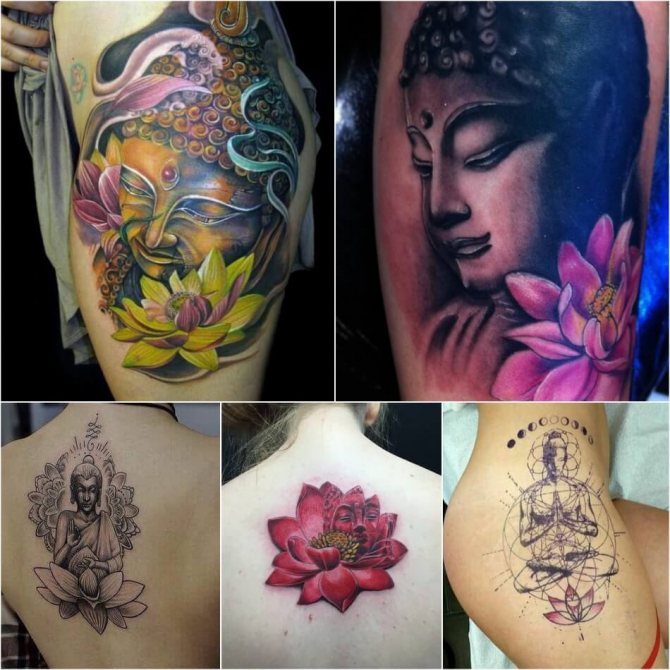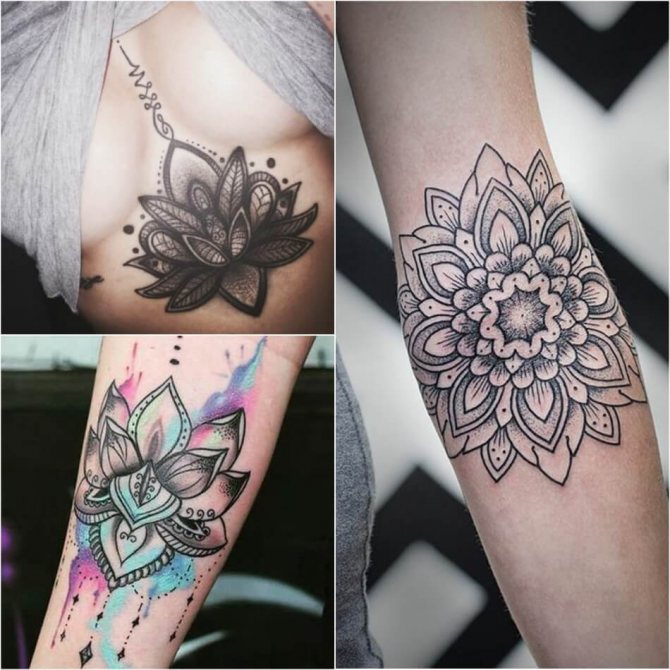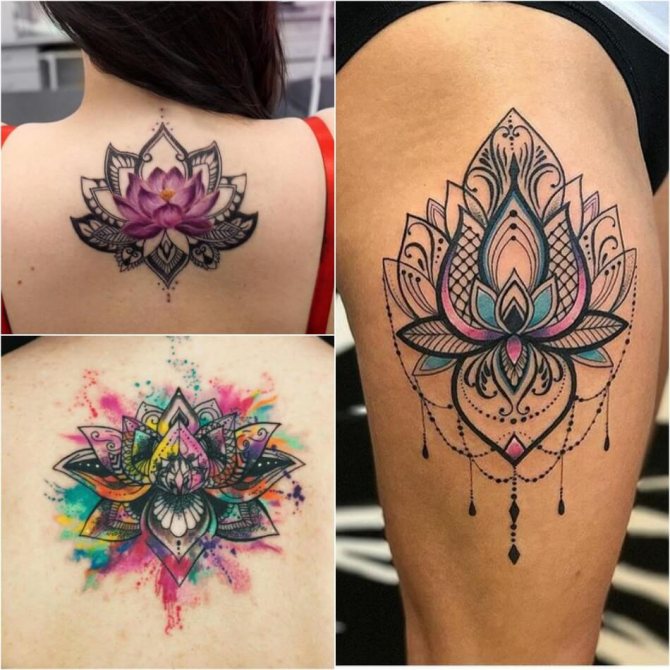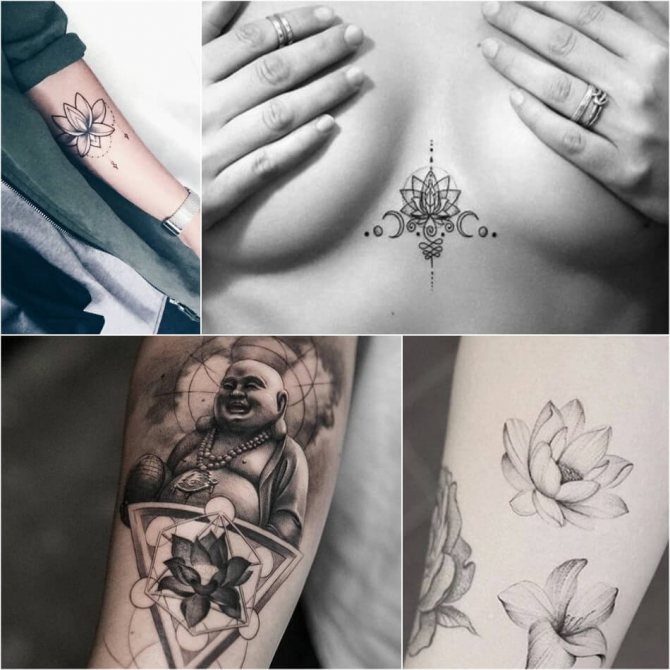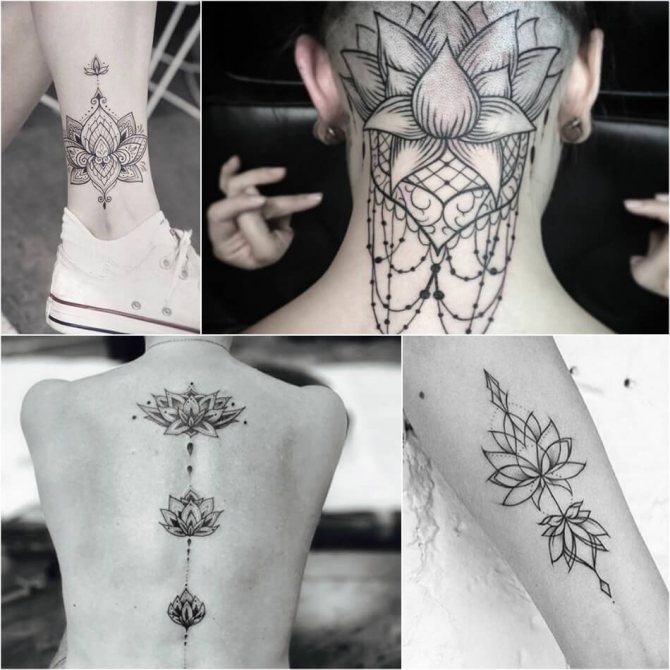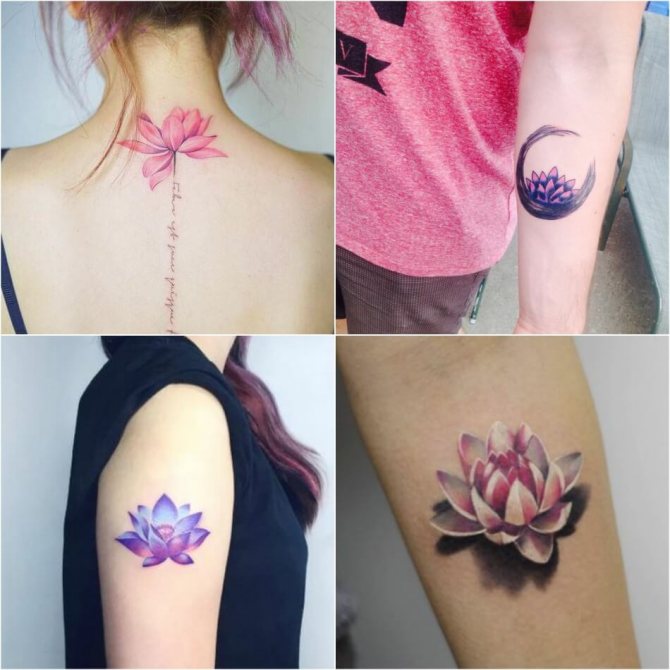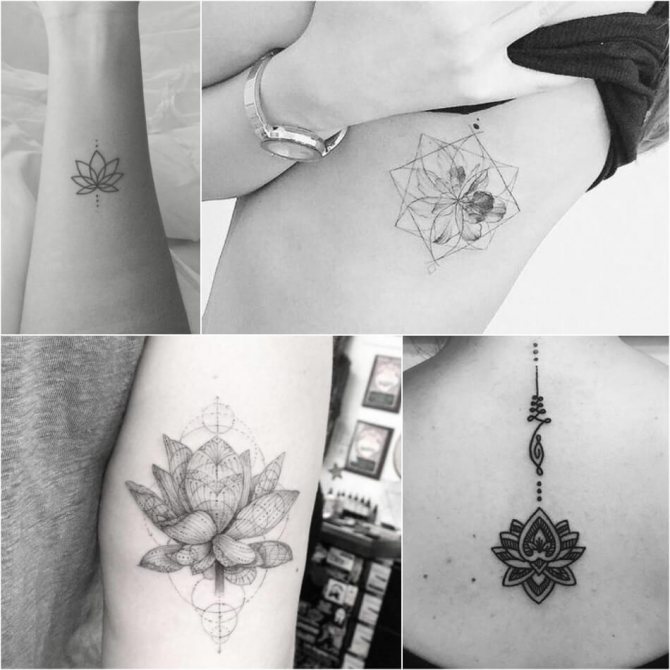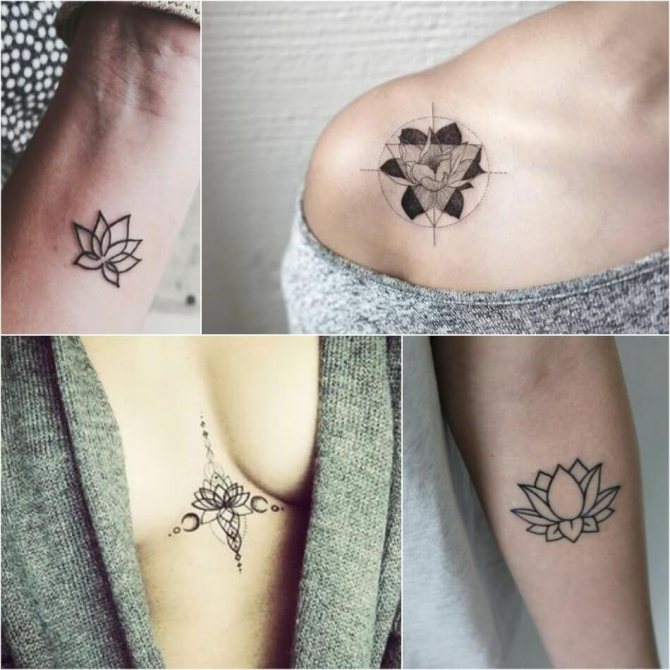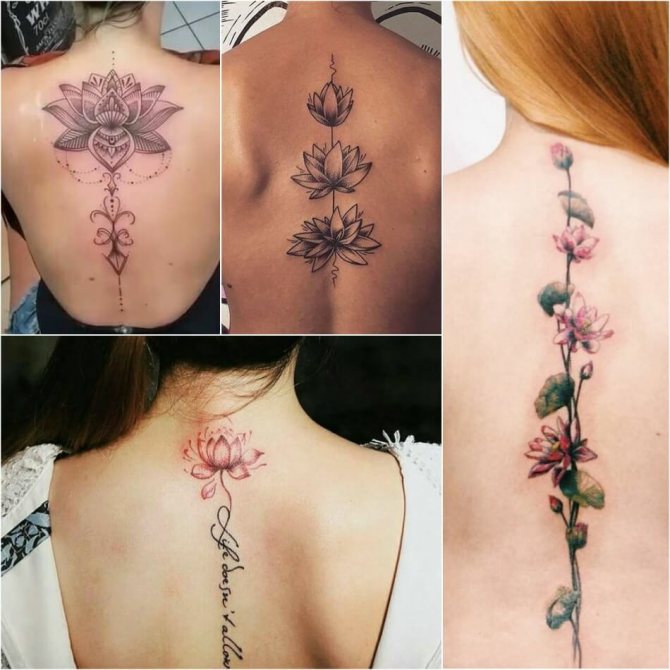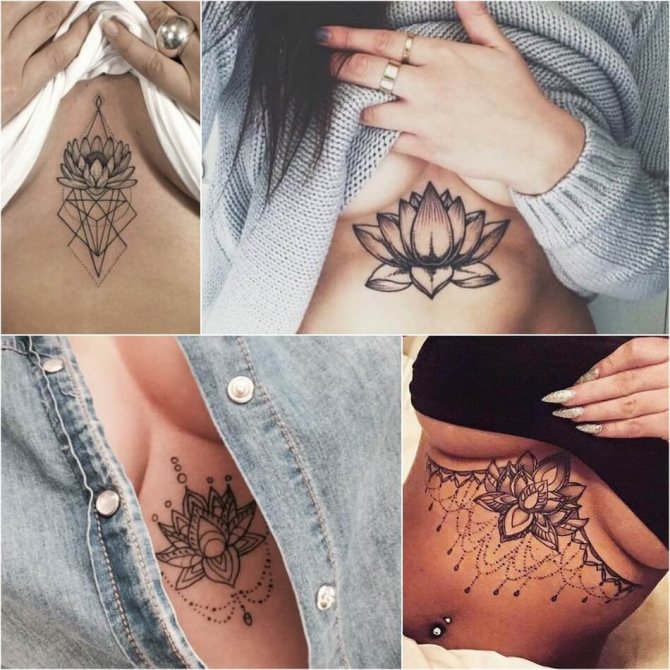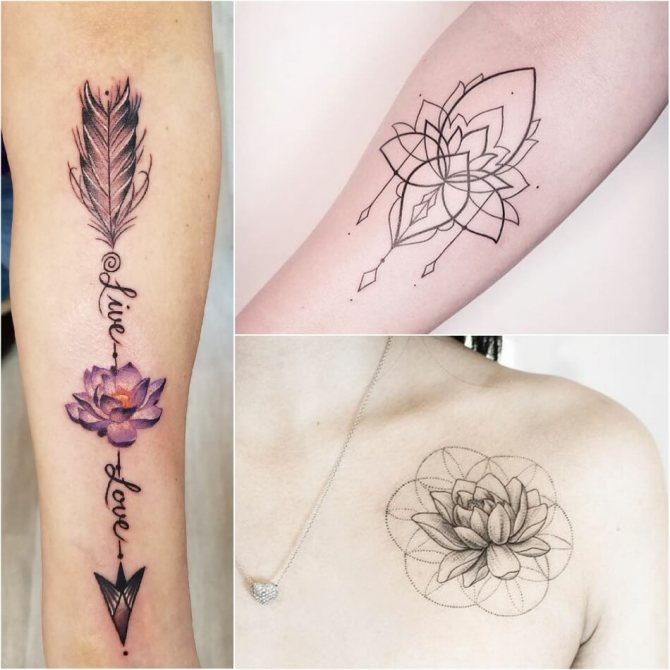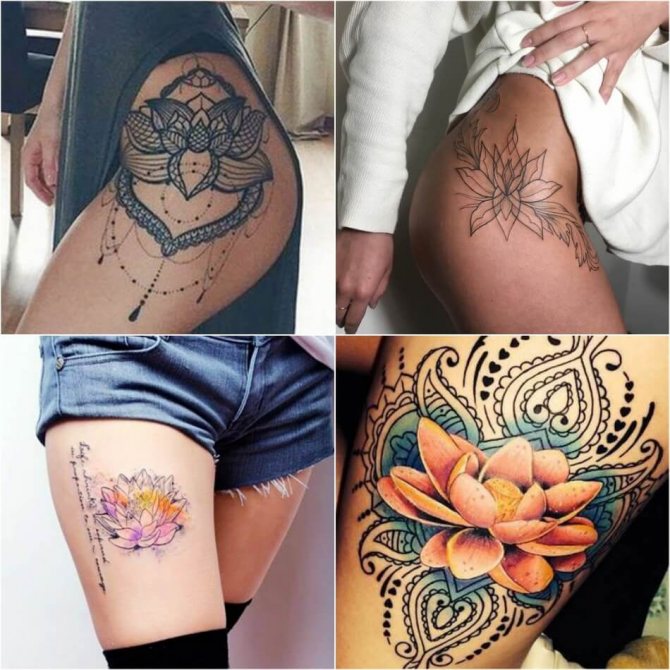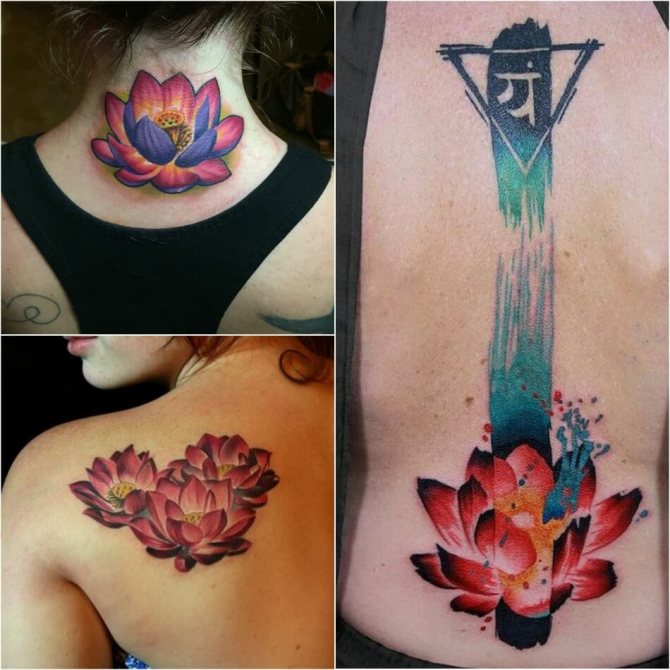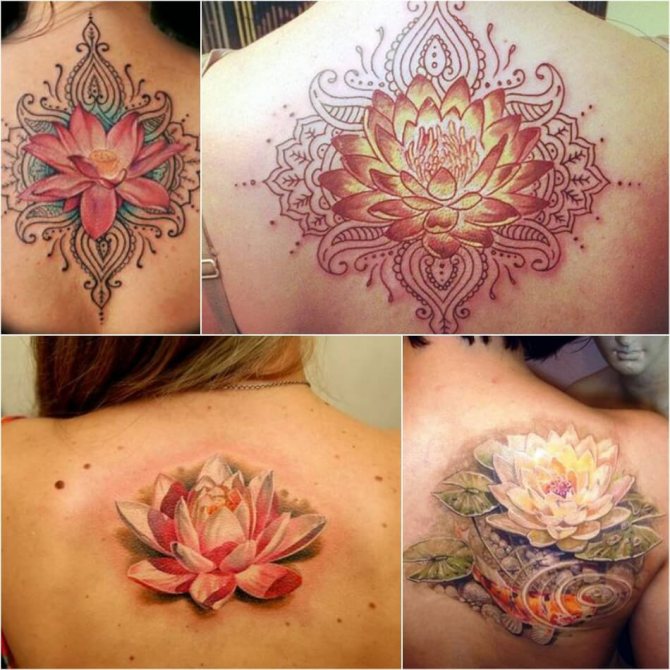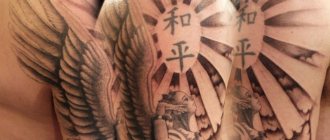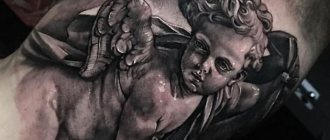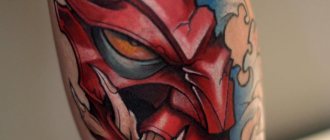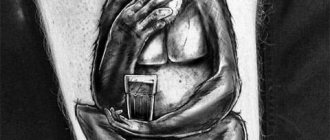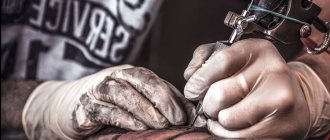From the Arabic word "khamsa" is translated as "five", and the sign appeared in antiquity, even before the emergence of any religions. The symbol was drawn as a symmetrical image of an open palm, which was flanked by two identical thumbs, and the three middle fingers were raised. At all times, the five fingers, which were displayed as a greeting, symbolized friendliness, absence of weapons and hostile intentions. Hamsa as a sign has long since acquired the meaning of a strong talisman, protective amulet in all cultures and has not lost this meaning in the modern world.
Types
The tattoo can have different directions and this indicates its meaning:
- Fingers down - the tattoo is done by women. The amulet protects women as mothers. Helps with conception, pregnancy and childbirth, breastfeeding. Protects against extraneous harmful influences and the evil eye;
- Palm with a pair of fingers - a sign of eroticism in the wearer;
- with five fingers - symbolizes inspiration and wisdom, which is contained in ancient Hebrew books.
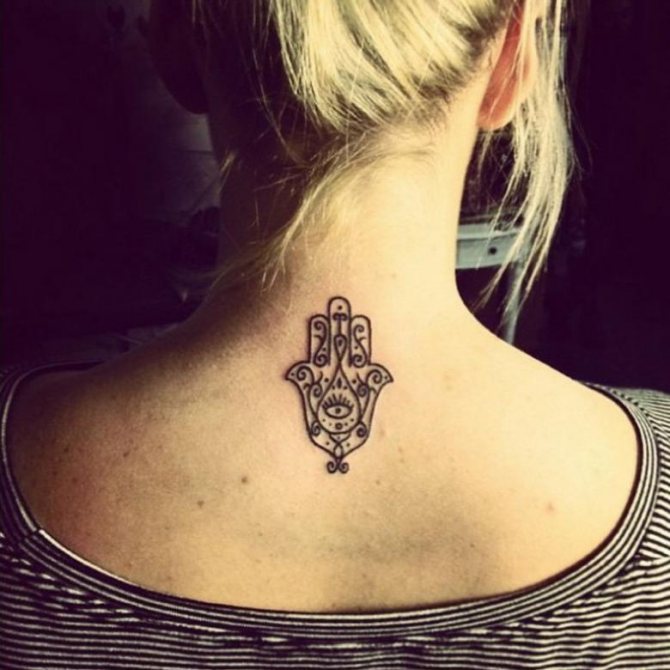
Variety in appearance and materials of the piece
The hand of Fatima can be made of any materials. But it is believed that in order to reflect hostile energies, it is important that the surface of the amulet be mirror, that is, reflective.
When making Khamsa, gold and, less often, silver are used as precious metals.
Gold is an activator of energies, while silver is the opposite. Therefore, gold attracts the good, and silver repels the bad.
WARNING If you complement your jewelry with blue (for example, enamel inlays or turquoise), the protective qualities will be enhanced.
Inserts are made traditionally of turquoise or blue enamel.
In Islamic tradition, the color blue is considered protective of the evil eye and evil forces. It is recommended to wear a talisman as close to the body as possible.
There are various uses for it as jewelry:
- Hamsa ring (worn both on the lower phalanges and on the upper phalanges);
- Hamsa bracelet (supplemented with elements in the form of fingers and other symbols);
- Hamsa pendant (worn both around the neck and on the arm). It is believed that such a pendant, worn on a red thread, promotes, among other things, the strengthening of health;
- The pendant is recommended to be worn on a separate chain or lace.
It is not customary for adherents of the Orthodox faith to wear both the image of the cross and other symbols around their necks at the same time. Therefore, in the case of wearing a cross, choose other ways to keep the amulet Hamsa closer to the body.
The blue eye, the holy eye of Horus
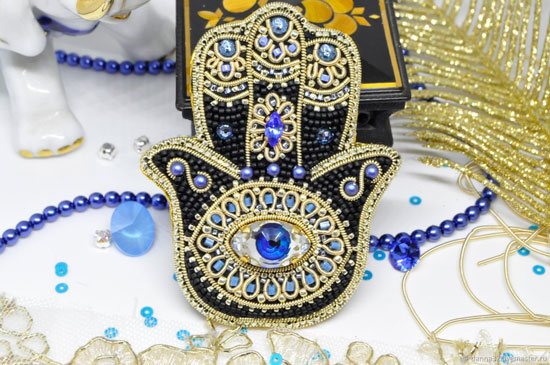

In ancient Egypt, the symbol of a palm with an eye in the center was used to decorate ritual objects (such as sarcophagi). It was believed that this eye belonged to the god Horus.
The meaning of the symbol "eye on the palm" depended on the orientation of the eye: if it was the left eye, it helped to heal and prolong life, and if it was the right eye, it protected from evil forces.
There were two versions of this sign: white - for the living, and black - for the deceased.
Drawing
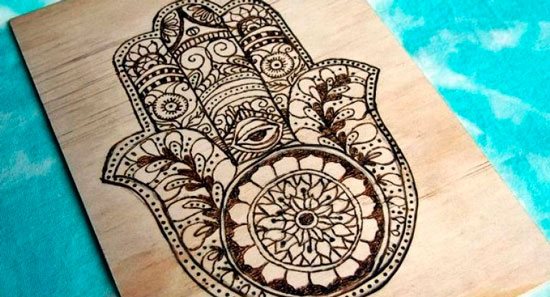

Hamesh drawings are mainly used to protect a dwelling or other premises from intrusion by malevolent persons.
Such images are often accompanied by written blessings and are hung either at the entrance or directly in front of it.
You will be interested in: Wedding Bugle - the meaning of the Slavic amulet for the young family
It is believed that this protects not only from burglars, but also from fire.
Embroidery
The Fatima hand embroidery is used in much the same way as the painted image.
It can be found on carpets, tapestry paintings, elements of clothing (to be worn closer to the body).
In addition to protecting the home, wall decoration is intended to improve the well-being of the owners of the home and contribute to the fulfillment of their wishes.
There are other uses for embroidered and drawn images: they are placed in the cabin of a car to prevent accidents and theft.
Tattoos on women
This tattoo is usually female. The image, as a talisman, was fixed at the cribs of infants to protect them from the evil invisible world. The symbol was worn by pregnant women for successful childbirth.
For women, the tattoo Hamsa represents tradition, family, comfort and security. The symbol is strengthened by additional applied elements. For example, the addition of the lotus plant means purity, peace and absence for anxiety.
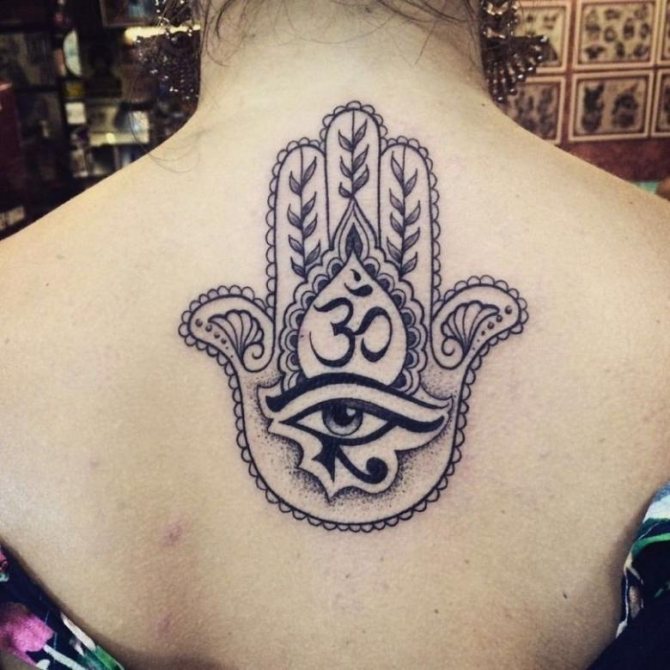

The most popular styles for women are linework, minimalism, and graphics. It is possible to create dye undertones in watercolor style. The tattoo gets a cheerful and positive look.
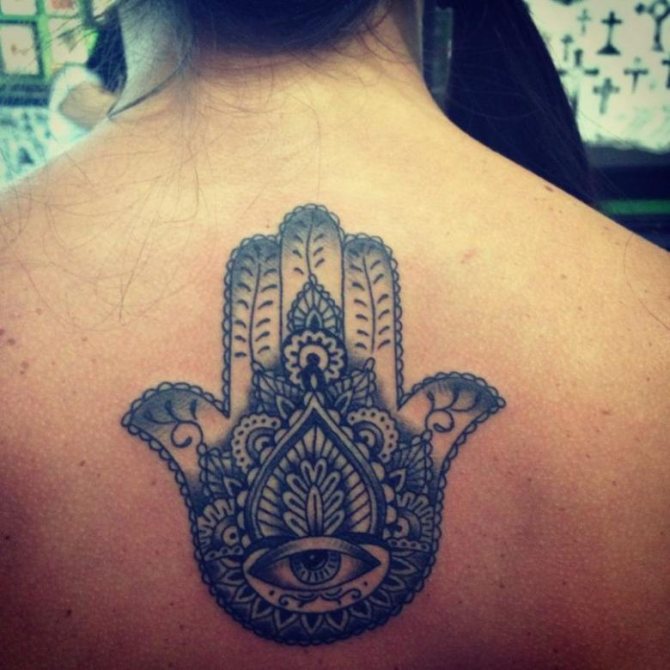

An important stage in the business of tattooing is the choice of the sketch
Today to pick up the "perfect" for yourself sketch of a tattoo is not difficult - the Internet is replete with photos of various variants of sketches, drawings and sketches with the image of a hamsa. Also, any qualified tattoo master offers his services to create an individual sketch for each client.
How the future body image will look depends not only on the choice of a suitable location for the tattoo and a particular artistic style of tattoo images, but, above all, the value invested in it.
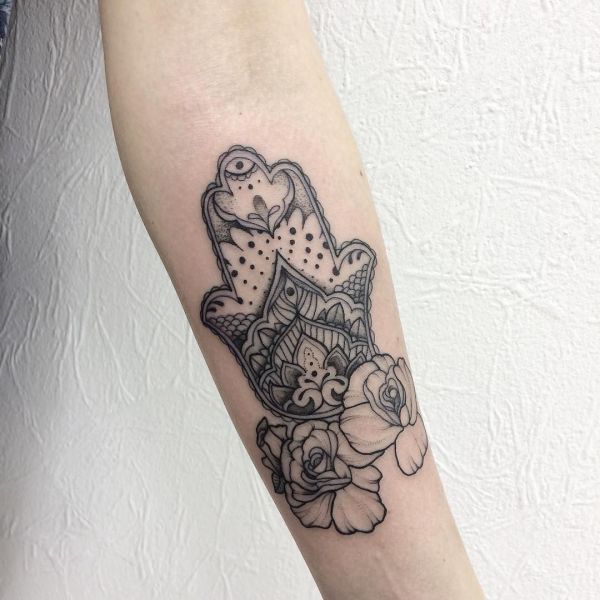

Tattoo hams with flowers
Tattoo in men
Men apply the symbol for self-realization. They use the occasion to boost self-esteem and use additional details in the drawing to enhance its effect:
- The symbol of the eye, placed in the middle of the image, is the all-seeing eye. Therefore, protection is provided around the clock. Such a supplement helps to increase intuition, and sometimes gives the gift of foreseeing the future;
- to attract good luck inscribe the sign of the fish or the Star of David. They promote goals in sports, entrepreneurship and personal relationships.
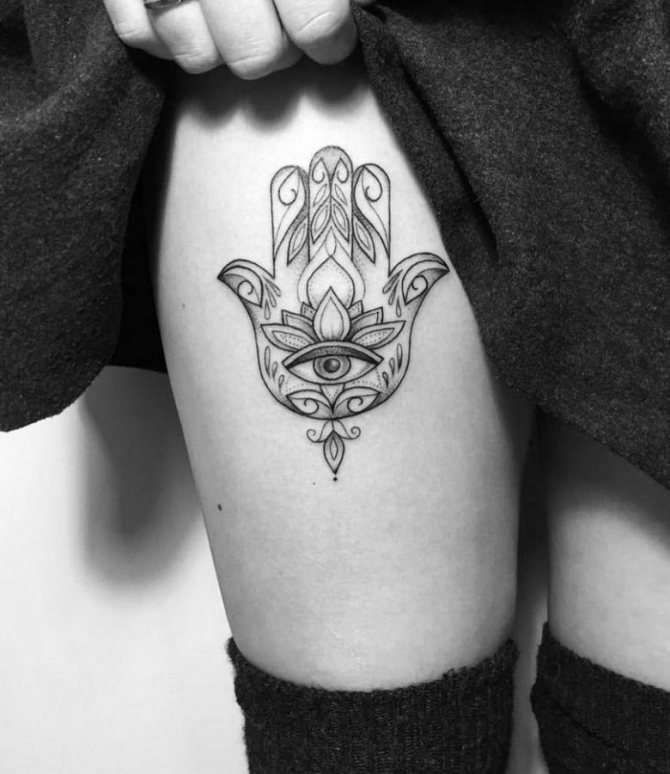

Tattoo is applied mainly on the surface of the back. The idea is to prevent an attack from behind, from the rear, to avoid attacks in the back.
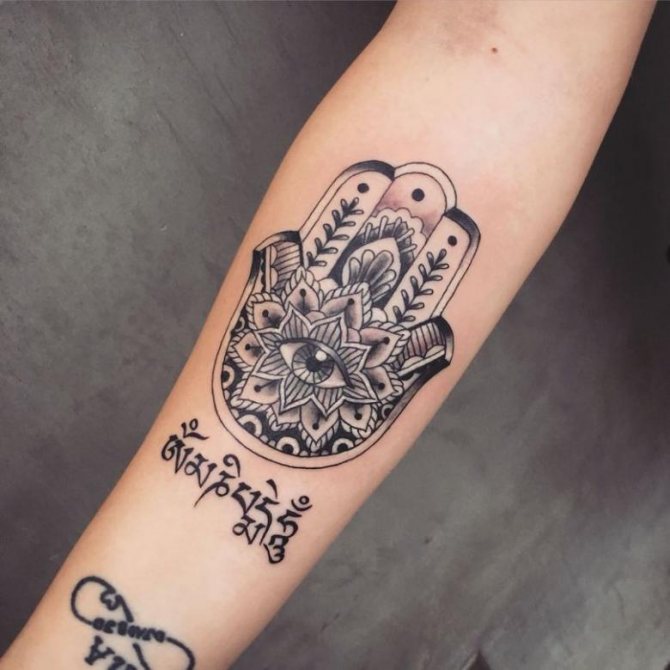

Michelangelo's fresco "The Creation of Adam": what does it mean?
The book of Genesis, the Pentateuch of Moses, sets forth the "theory" of God's creation of the first man on earth in His image and likeness. Michelangelo's The Creation of Adam, the famous Italian painter of the Middle Ages, used this particular biblical subject.
Michelangelo's The Creation of Adam
This work belongs to the technique of fresco painting, which reached its highest development in Renaissance Italy:
- The classic technique of painting in this way is the use of paints applied over raw plaster. The latter contains lime which, as it dries, covers the image with a thin film of calcium salts, giving it long-lasting durability;
- This work by the artist (even more than the sculptor) was created in this manner during his work in 1508-1512 on the painting of the plafond (ceiling) of the Sistine Chapel in the Vatican. It was the centerpiece of a huge composition commissioned by Pope Julius II.
- The subject of the fresco is believed to be based on the process of the Almighty "animating" the young man's beautiful body and transforming it into a living being endowed with a soul and life energy. This is evidenced by the gestures of the hands of God and man, directed toward each other, symbolizing their mutual attraction. It seems that they are about to close ... but it is not a fact, it is only seen. The heavenly and the earthly are here divided.
How did Michelangelo carry out the commission of Pope Julius II?
The work process was not at all easy for the artist in every sense of the word.
Though generally more of a sculptor, Michelangelo was by no means eager to paint frescoes on the ceiling of the church. He had no such experience, and he received this peculiar order from the pope as a result of the intrigues of his ill-wishers.
Initially Buanarotti asked some artists he knew to help him master his new style of painting, but he quickly realized this and rejected their services, preferring to work alone. However, two assistants worked with him, one of whom mixed the paints, while the other covered the surface with lime, on which the master subsequently applied his brilliant strokes.
By the way, it was not easy psychologically and even technically, as the specificity of this type of art did not allow for corrections and amendments. The work had to be done "clean" at once. The talent of sculptor and "volumetric vision" of the future image helped the artist here, he even felt a taste for the new business.
True, after its completion for a long time came to recover from the constant vision of the paintings from the bottom up, as he had to work lying down. Even books he read for some time only in this position.
Where is the painting?
From all the above you have already understood that it is one of the frescoes (but the most important) on the plafond in the Sistine Chapel in the Italian capital, Rome:
- The latter is now a museum of Renaissance art, and its premises have been the site of conclaves - the election of each new pope since that time. Its famous church choir is also widely known;
- The chapel was built in the last quarter of the 15th century at the request of Pope Sixtus IV (from which it takes its name) and was originally a house church. The architect and supervisor of the construction was Giorgio de Dolci;
- The walls and ceiling of the temple were painted by famous medieval artists, among whom, in addition to Michelangelo, are Raphael, Botticelli, Perugino, Ghirlandaio, Roselli and other famous masters;
- In a grandiose fresco composition on the rim of the church, the artist arranged 9 paintings from the Holy Scriptures from the creation of the world. Among them, in addition to the one mentioned, there are also pictorial subjects about the separation of land from water and light from darkness, the fall and expulsion from paradise, the creation of the luminaries, etc.
- The last reconstruction of the frescoes in the chapel took place at the end of the 20th century.
Features
The color scheme also makes an impact. Blue and green colors make the painted image stronger. Men prefer a drawing in one color. The blue color for such a tattoo is considered traditional, the most appropriate and enhances the amulet. Dotwork style is performed in black, less often in red.


Additionally, the tattoo can be filled with images of oriental ornaments. The size of the tattoo varies, small or medium size. This allows you to apply it to different parts of the body. Attractive look at the tattoo when applied to the wrist. If necessary, it can be hidden under a bracelet. The tattoo is done on the neck, scapula, shoulder or forearm.


This tattoo covers skin scars and scars.


When applying the Hamsa tattoo, the main role is given to the skill of the master. Hamsa tattoo has a small size and requires precise drawing of details. It is also relevant in the case if you have chosen a complex ornament and a lot of details. The master needs to have knowledge of every detail of the drawing. The tattoo is not only for beauty, but also to protect the wearer.


Most often, the "hamsa" tattoo is performed in the Dotwork style. It is used in the application of Oriental patterns and ornaments. In this case the performance is as follows: separate points are made on the contours of the figure with varying distances. This creates the effect of color transitions.
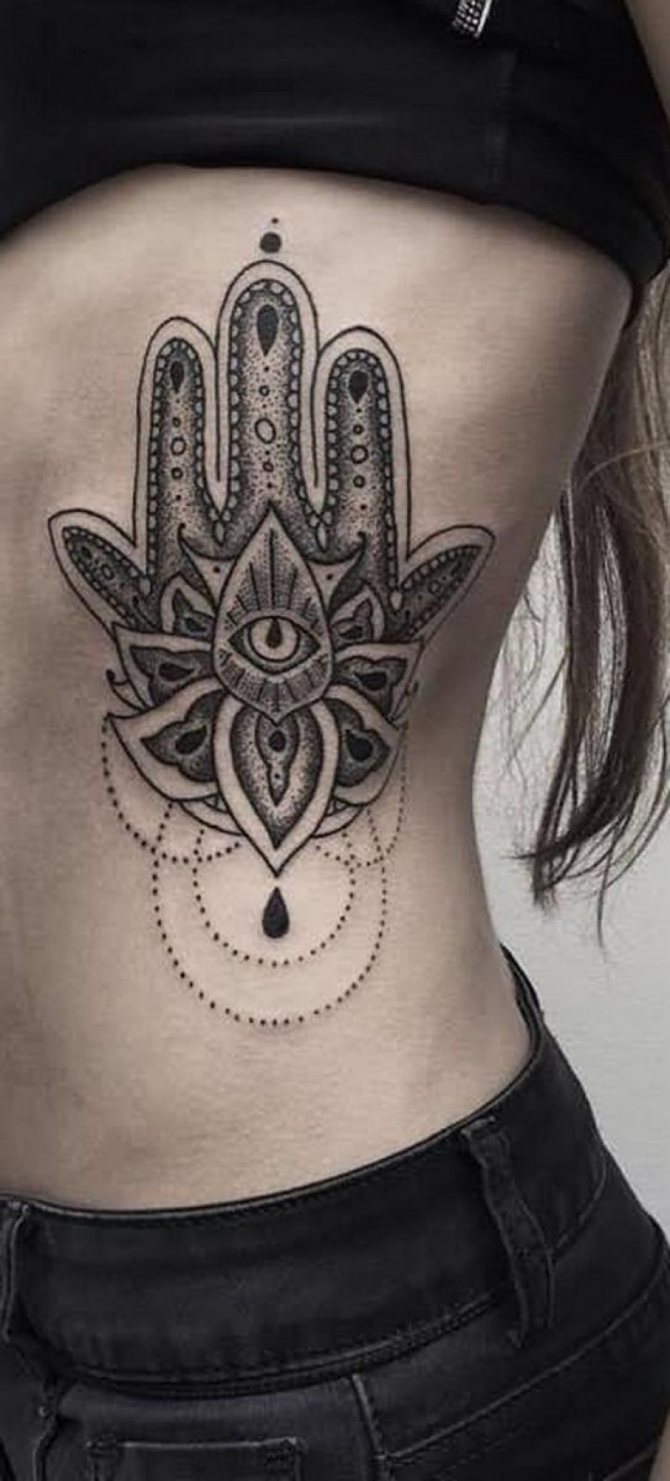

Hamsa meaning
Despite the fact that the hamsa is considered an eastern symbol, the image of the palm is found everywhere. Scientists have found the pattern while studying the remains of ancient civilizations not only in Asia, but also in Africa and America. Finds were united by the same idea embedded in the sign - it is protection, the magical power of the "God's hand", giving blessing, good luck, guarding against the evil eye.
In Jewish communities khamsa called "hand Miryam" and is considered a symbol of the "five holy books of the Torah" - the first five books of the canonical Jewish Bible. The hamsa is popular among Jews who live in the Islamic world and believe that the hand should remind the wearer of the need to glorify G-d with all five of their senses.
Among Arabs and Berbers the expression "five fingers in your eye" is common, denoting the desire to ward off spoil, to prevent the influence of people who have plotted or wished something unkind. Arabs consider Hamsa their national sign and complement it with a drawing of the Muslim crescent. The symbol is called "the hand of Fatima", linking the powerful power of the amulet with the story that happened to the only daughter of the prophet - Fatima.
According to legend, the girl who was making sweets dropped the spoon in grief when her husband brought and introduced her to his new wife. The pain of the unexpected news was so strong that Fatima did not feel the burn, stirring the boiling halva with the palm of her hand. That is why the hamsa became a true symbol of patience and faith. The Egyptians had a picture of khamsa adorned almost all the walls of dwellings and temples, met on the sides of boats, sacred steles. The sign was carved to protect against enemies, so that the magical power protected the owners from curses.
In Native America, the picture of a palm signified supernatural abilities and was always complemented by an image of an open eye in the middle of the forefinger. This symbol helped one to expand one's consciousness and discover new skills. It was found frequently in both Mexico and the southeastern Americas.
In Tibet the "all-seeing protector" is an object of worship and requests for patronage to this day. The Buddhist goddess Tara is depicted with an unfolded palm raised at chest level and an eye painted on it. This gesture is the embodiment of care and comfort, which all those who suffer receive, turning to prayer. An amulet in the form of a hamsa is a popular remedy in Tibet to relieve fears and oppression.
In Christianity, the image of the "hand of God" is often found in religious pictures and denotes help and protection of God. Drawing the hand arising from the clouds and bringing comfort to the wandering and the poor. In Russia, the word "hand" has long been associated with the concepts of "power", "ultimate justice", "dominance".
Sketch .
Before applying the tattoo to pick up the desired sketch. You can choose a picture on the Internet, in a salon or discuss with the master individual variant. It is important to understand in advance, what meaning the bearer puts in the tattoo mascot "khamsa" and to what aspires - to protection or to leadership.
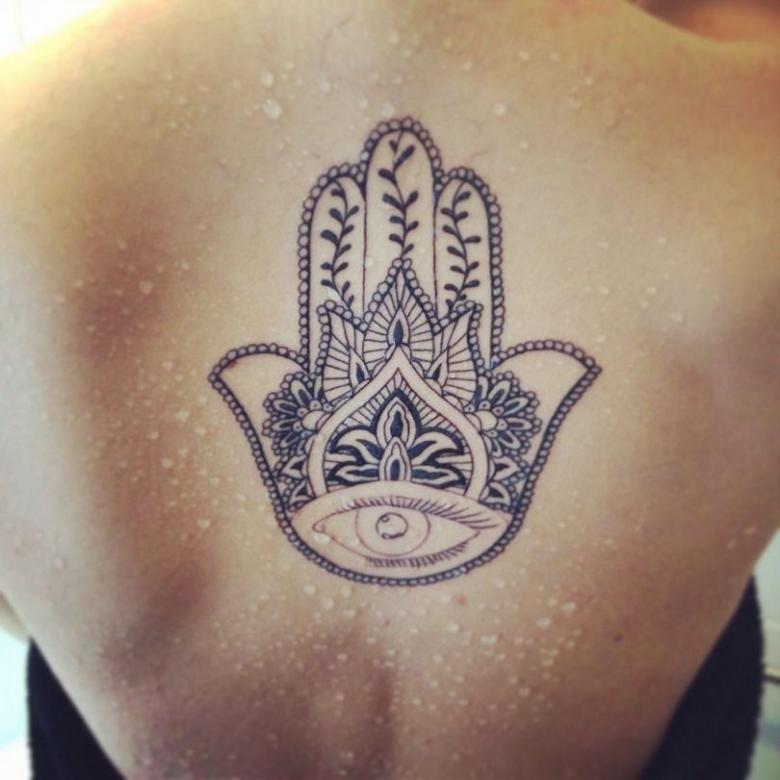

It should be borne in mind that the sign can have a real impact on the life of its bearer in the future. In this case, it does not matter the religion of the wearer - the sign is present in all religions. If a person is not inclined to believe in esotericism, then the drawing may be done only for beauty.
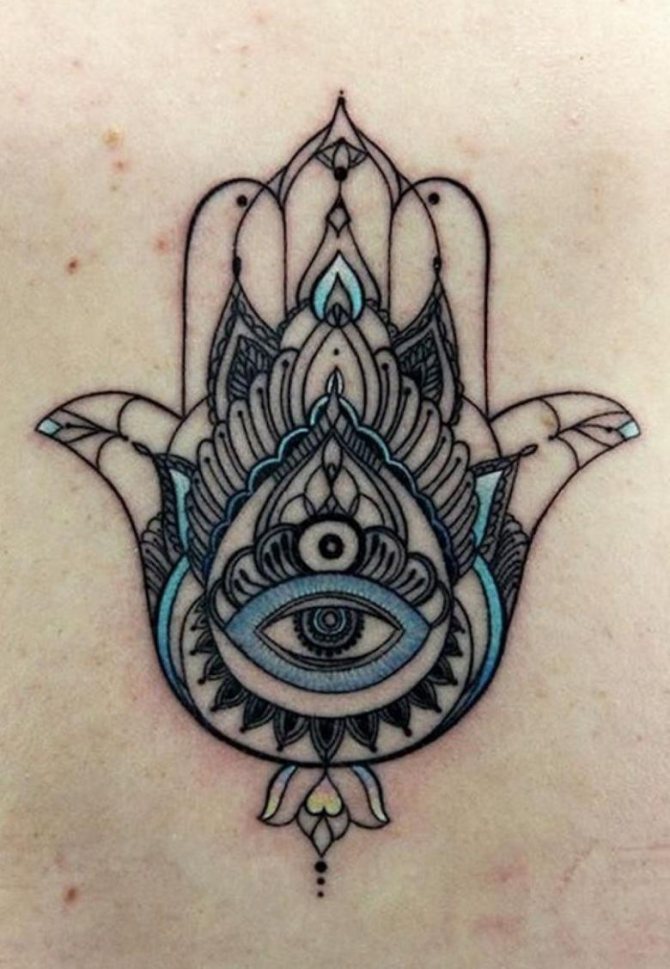

The simplest version of the picture is a stylized palm without any additions, with symmetrical fingers. Such a drawing is preferred by those who put in it a mystical, esoteric or religious meaning.


A good drawing is supplemented with other images:
- The contours of stars. They are harmoniously combined with the palm. This enhances the mystical meaning and looks good on the outside;
- An image of an eye or eyeball. This symbol is placed on the open prominent places. Another name is the "eye of Horus" for protection;
- heart. Symbolizes happy love, good relationships. Preferably young women and girls;
- flower. Meanings are not only flowers, but also the number of applied petals;
- elephant. A symbol of wisdom.
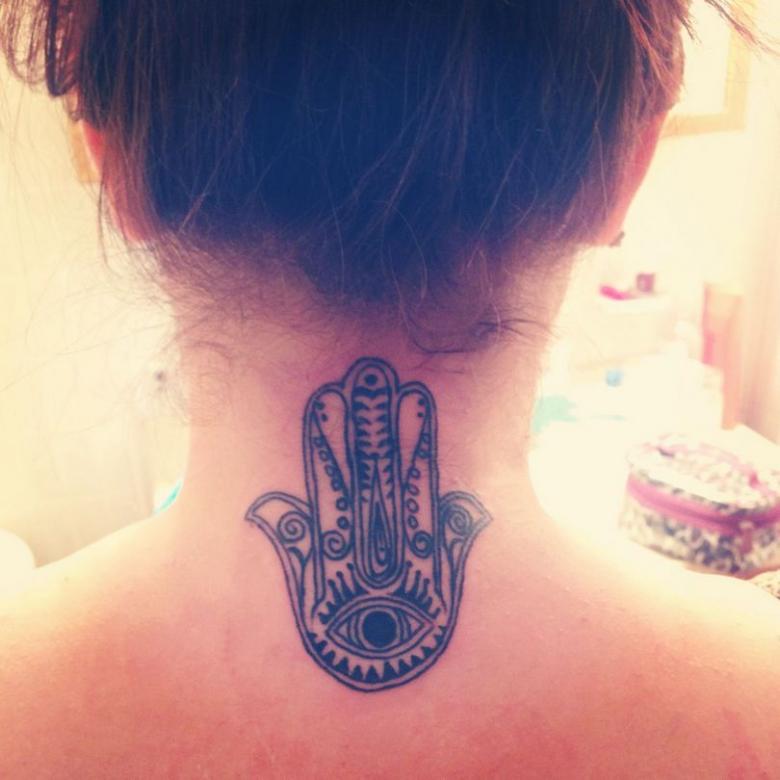

Thus, the tattoo "hamsa" provides room for the imagination of both the user and the master.
The meaning of the tattoo for girls
On the female body the image of the universal talisman acquires a specific meaning if you draw the palm of Venus, Aphrodite or Mary - all these virgins provide the owner of the tattoo strong female health, the ability to give birth to healthy children, to nurse them with their own milk and easily endure the period of pregnancy. Girls who choose the classical style khamsa tattoo dream about a strong family, the happiness of motherhood and will strive to create a cozy family nest.
For modern women, the khamsa tattoo is often not just a decoration, but also a symbol of patient and resilient character. By choosing the image "the hand of Fatima" for a tattoo, girls hope to find traits without which it is impossible to live in harmony with oneself. In the harsh realities of our time, the hamsa reminds of the need to show mercy, sincere faith and pray that the soul is not calloused.

